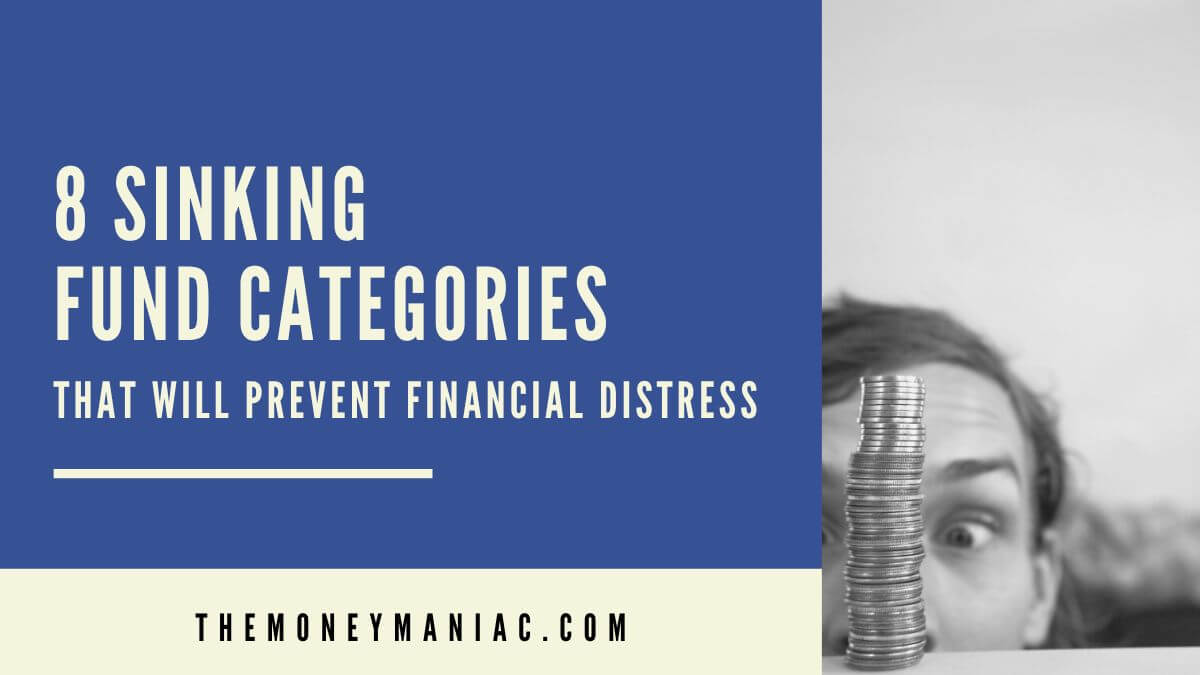Long-term financial planning is a challenge. And budgeting is where the rubber really meets the road. Because no matter how well you plan for the future, something unexpected always seems to get in the way.
But what if we could expect the unexpected? And what if we were prepared for all the curveballs that life throws our way? As it turns out, we can — with sinking funds. These are the failsafe, foolproof financial safety nets that everybody should have in place.
Whether it’s a broken-down car or a sudden trip to the emergency room, there are sinking fund categories for anything and everything.
This article covers the ins and outs of sinking funds, 8 essential categories to adopt, and how to build them into any budget. Let’s dive in!
What Is A Sinking Fund?
A sinking fund is a strategic savings account that you set up in advance to cover specific, predetermined expenses.
Sinking funds function like escrow accounts that help you put aside money for future costs without depleting your primary savings account.
In essence, they serve as mini-life rafts for your finances, keeping you afloat through the rough waters of braces, home repairs, and more. Instead of attempting to cover a large expense all at once, sinking funds encourage you to save a little bit every month until you reach your goal.
Why Are Sinking Funds Important?
Sinking funds enable you to plan for upcoming obligations without derailing your monthly budget. This practice is beneficial in two key ways.
For one, the act of saving money can help you develop better financial habits in the long run. Since you are putting money away for specific goals, you should be less likely to spend it elsewhere.
And second, planning ahead for inevitable costs protects you from tapping into your credit card or emergency fund for every expenditure that comes up. This, in turn, prevents you from accumulating high-interest debt and experiencing financial distress.
What Sinking Funds Should I Have?
There is a wide variety of sinking fund categories for every expense you may encounter, from travel plans to pet needs to car breakdowns. And while the specifics of each expense may vary, the fundamentals of most budgets overlap in a handful of high-priority areas.
So if you find yourself wondering… “What sinking funds should I have? And how much should I set aside for each?” The answer of course depends on your own lifestyle, needs, and upcoming expenses. But to get the ideas flowing, here are 8 sinking fund categories that everyone should consider adopting in their budget.
8 Essential Sinking Fund Categories
Emergency Fund: When Life Throws You A Curveball
The emergency fund is the superhero of sinking fund categories. It is the cornerstone of every sinking fund strategy, and often the only sinking fund that individuals maintain.
Financial professionals generally advise you to put at least three to six months’ worth of expenses aside in your emergency fund. This is intended to cover you (and your family) in the event of sudden job loss, injury, or other unforeseen catastrophes that prevent you from generating income for a period of time.
However, this fund is not intended to cover auto repairs, travel costs, holiday gifts, or other predictable expenses. Those should be stored in separate sinking funds that can be accessed when necessary.
The issue with keeping only one sinking fund — the emergency fund — is that people are often tempted to use it for non-emergency purposes. Then, if a true emergency arises before you have replenished the sinking fund, your only option may be debt.
Pro Tip: It will take some time to establish a complete emergency fund. Don’t worry about starting small as long as you keep contributing until you reach the target amount.
Vacation Fund: When You Need A Break From Adulting
Life is stressful. And chronic stress can be deadly. That’s why it is important to relax and unwind when you can. Whether it is an overnight stay at a local hotel or an extended cruise across the Caribbean, a vacation fund can help you plan for and cover the costs of a much-needed getaway.
A vacation fund is for airfare, lodging, meals, outings and activities, travel gear, and accessories. As you accumulate funds in your vacation account, you can begin to book trips with peace of mind. Just remember to account for all expenses beforehand, including transportation, accommodation, food, and activities.
Pro Tip: To get the most out of your vacation sinking fund, utilize credit card points and other rewards programs to save money on airfare, hotels, car rentals, and more.
Home Repair Fund: When Your House Starts Falling Apart
Buying a home is a rewarding experience — until something goes wrong and you’re slapped with a hefty repair bill. A home repair fund is a great way to save for the necessary maintenance that comes with homeownership.
To start forming this sinking fund, make a list of any prospective repairs you might need to make to your home in the upcoming years. This may include patching a leaky roof, restoring a broken window, or replacing an old appliance. Find out the average cost of those repairs in your area and set a savings target accordingly.
Then, each month, place a portion of your earnings into the sinking fund so you will be ready when something breaks. As a rule of thumb, experts recommend setting aside 1% to 2% of your home’s value each year for this purpose.
Pro Tip: To identify foreseeable repairs, take the age of your home and compare it to the lifespan of its major components, such as the roof, HVAC system, and appliances. These major expenses often come due at fairly predictable intervals.
Medical Fund: Because Your Health Is Your Wealth
Even though health is wealth, investing in your health can be quite costly (even with insurance). Think of your medical fund as your budget’s multivitamin — it keeps you fit and healthy by ensuring that you can afford annual physicals, preventative treatments, and even medical emergencies.
To begin, estimate the cost of your healthcare needs for the year. Plan for regular check-ups, medicines, and any ongoing treatment. Total all of these expenses, divide the total cost by 12, and then add an extra layer of cushion. This is how much you should set aside each month.
Ideally, you will end the year with a balance. This can be carried forward to the next year and slowly accumulated for more extensive treatments, beyond the regular co-pays and deductibles.
Pro Tip: If you are eligible, consider starting a Health Savings Account (HSA). HSAs offer powerful tax benefits which effectively reduce the cost of healthcare.
Car Maintenance Fund: When Your Car Needs Some TLC
Your car may be your trusty sidekick, but it can become a money pit when neglected. A sinking fund for car maintenance is essential if you want to avoid costly repairs in the future.
Start by asking a trusted mechanic for a list of recommended car services and the associated costs. This includes both scheduled inspections as well as any repairs you may have postponed in the past.
Much like a home, car experts recommend you save 1% to 2% of your car’s sticker price each year for service. This can help you cover expenses like new tires or brakes, oil changes, or even a tune-up without going into debt. And if you have an older car or one with high mileage, be sure to plan for more significant repairs such as engine, transmission, or suspension replacement.
Pro Tip: Use preventative maintenance and safe driving practices to minimize your car-related expenses. And always shop around for car parts to get the best price.
Pet Fund: When Fido Needs A Check-Up
Pets bring joy to our lives, but they can also bring unexpected expenses. A pet fund is an effective way to save for your furry friend’s medical and wellness needs. Having a pet fund can help you handle these expenses without breaking the bank, whether it’s a trip to the vet, a grooming session, or new toys and treats.
Set your savings goal based on your pet’s age, breed, and health history. Even just $10 per month per pet can add up over time. This will help you cover expenses like check-ups, vaccinations, or the occasional health scare with ease.
Pro Tip: Start your pet fund as soon as you bring your new four-legged friend home and consider getting pet insurance for additional peace of mind.
Holiday Fund: When You Want To Share The Love
Gift-giving and holiday celebrations can be costly, especially if you have a large family or social network. Putting money aside throughout the year can assist you in budgeting for gifts, travel, and other holiday-related expenses. Birthdays and weddings can pile up as well.
A holiday fund allows you to save for these special occasions and pay for gifts for decorations, entertainment, and even visit friends and family without depleting your bank account. Before you begin saving, list out who you need to buy gifts for and potential ideas for each person. This can help you budget and work backward to determine a monthly savings amount.
Pro Tip: Get an early start on holiday shopping to take advantage of deals and discounts. Or, buy gifts when they are freshly out of season. This might mean summer clothing in the midst of winter or Christmas wrapping paper in January.
Education Fund: For Investing in Your Future
Education is a wise investment, but it is not cheap. Whether you want to go back to school or save for your child’s future tuition, an education fund helps you budget for the skyrocketing costs. Creating an education fund can also prevent you from taking out student loans or using credit cards to cover educational expenses like books, school supplies, and programming fees.
When opening an education fund for your children, keep in mind their age(s). Not only will this determine how long you have to contribute to the fund, but it will also help you project the potential costs.
If the fund is for yourself, consider what kind of degree or certificate you want and the associated expenses. While you may not have as long to save, you probably have a better handle on the total price tag. And this will enable you to calculate your monthly contribution. But don’t forget to research potential scholarships, grants, and other financial aid options to help supplement your education fund!
Pro Tip: Start saving early to benefit from compound interest. And take advantage of a 529 plan to enjoy tax-free earnings growth if you are investing for your children.
Related reading: 21 Personal Finance Ratios That Will Boost Your Financial IQ
How Many Sinking Fund Categories Do I Need?
Now that we’ve discussed popular sinking fund categories, you may be wondering how many you need or how many is too many.
Unfortunately, the answer is quite personal and depends on your upcoming financial needs. If you don’t have pets or children, for example, you can eliminate pet and education funds. And if holiday expenses don’t disrupt your existing budget, you could potentially strike that sinking fund as well.
But in general, we recommend maintaining at least three to four sinking fund categories. This enables you to cover large, expected expenses like home repairs, car upkeep, and vacations. But if you experience expensive surprises outside of these sinking fund categories, you can create custom sinking funds for your own unique needs.
Remember that sinking funds are intended to help you plan for future expenditures without depleting your emergency reserve. With a handful of sinking fund categories, you can be more tactical with your savings and minimize the stress of upcoming bills.
4 Tips For Building Successful Sinking Funds
- Set realistic goals when creating sinking funds. To calculate how much you can save each month, analyze your existing income and spending. If your budget falls short of your goals, it might be a sign to consider building a second income stream or seeking out alternative ways to make extra money.
- Set up separate accounts for each sinking fund. Most banks will allow you to establish multiple no-fee savings accounts, which can be useful in sinking fund management. This way, you can avoid using your sinking funds for anything other than their designated purposes. But be sure that there are no minimum balance requirements!
- Automate your savings to ensure that you make monthly contributions. You can set up automatic transfers from your checking account to your sinking fund accounts with the help of budgeting tools like YNAB, EveryDollar, and PocketGuard. This will help you set aside money consistently, without any additional work required.
- Review your progress every few months to make sure that your sinking funds are on track. If you get a raise or a bonus, adjust your savings goals accordingly. This helps to manage lifestyle inflation and prevent yourself from getting complacent.
Final Thoughts
Sinking funds are an essential tool for good financial management. You can reduce the stress of future financial commitments by creating these funds for common types of expenses. Although we covered 8 popular sinking fund categories, these are not the only options that exist.
Reflect on your budget and where you have spent money in the past. Look for items that caught you by surprise or ended up costing more than you planned. These could be sinking fund categories to consider for the future.
No matter how you decide to divvy up your sinking funds, remember to stay consistent. Over time, these funds will start earning meaningful interest and giving you peace of mind. The goal is to be able to rest easy knowing that you’re prepared for whatever life throws your way!



